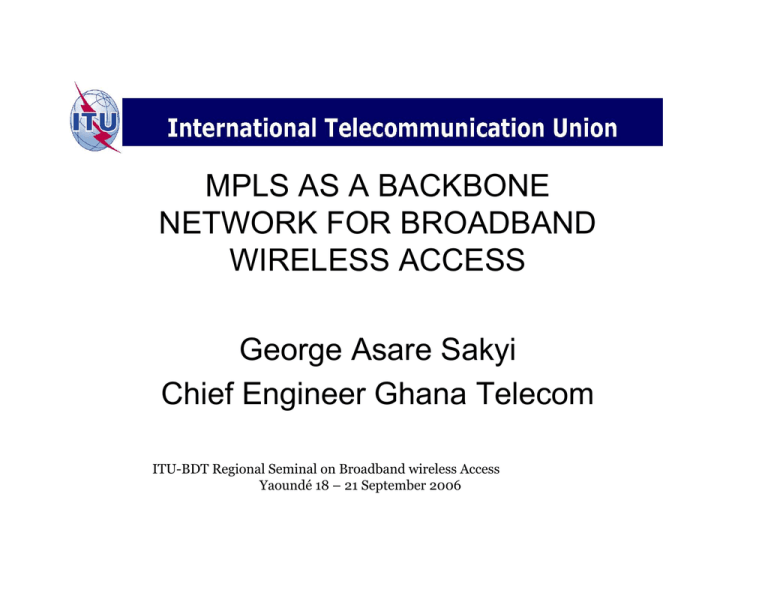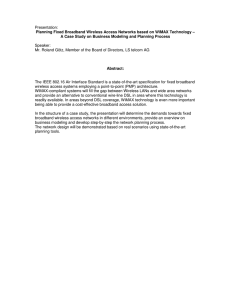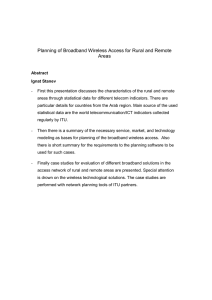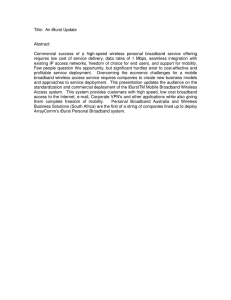MPLS AS A BACKBONE NETWORK FOR BROADBAND WIRELESS ACCESS George Asare Sakyi
advertisement

MPLS AS A BACKBONE NETWORK FOR BROADBAND WIRELESS ACCESS George Asare Sakyi Chief Engineer Ghana Telecom ITU-BDT Regional Seminal on Broadband wireless Access Yaoundé 18 – 21 September 2006 Outline of Presentation 9Background introduction 9MPLS architectural & functionality 9eMGW architectural & functionality 9Economic & social Benefit of bbwa & Conclusion ITU-BDT Regional Seminal on Broadband wireless Access Yaoundé 18 – 21 September 2006 Background introduction Competition between Mobile & Fixed lined Operators and the need to add value to the fixed line to be in business Telephone usage 3,000,000 2,500,000 2,000,000 Fixed lines 1,500,000 Mobile 1,000,000 500,000 0 1999 2000 2001 2002 2003 2004 2005 2006 ye ar Introduction of Broadband services ITU-BDT Regional Seminal on Broadband wireless Access Yaoundé 18 – 21 September 2006 Objectives of the Architecture and the Functionality of MPLS o To satisfy diverse VPN customer requirement taking into consideration that o Each customer has different security concern with a number of site at different location o Customers may be routing complex mission critical application with a defined traffic pattern and volumes o A service provider must therefore offer subscribers a portfolio that contains a number of different VPN service delivery models that can take care of the tradition VPN, Frame relay and ATM layer2 among others ITU-BDT Regional Seminal on Broadband wireless Access Yaoundé 18 – 21 September 2006 The Basics of MPLS • MPLS stands for Multiple protocol label switching • It could be defined as a mechanism that allows service providers to use their IP backbone to provide VPN services to their customers • A VPN is a set of sites which share common routing information and whose connectivity is controlled by a collection of Policies • The BGF element of MPLS is used to establish the virtual circuits and to forward VPN traffic across the backbone to remote VPN sites ITU-BDT Regional Seminal on Broadband wireless Access Yaoundé 18 – 21 September 2006 Primary objectives of the routing principles • To make service very simple for customers to use even if they lack experience in IP routing • To make the service scaleable and flexible to facilitate large scale deployment • To allow the service provider to deliver a critical value added service that galvanizes customer loyalty. • The main elements in MPLS network topology are; • The customer’s edge, Providers edge, Provider’s routers and the virtual private network routing table. ITU-BDT Regional Seminal on Broadband wireless Access Yaoundé 18 – 21 September 2006 MPLS NETWORK COMPONENT Provider Network CE PE P CE PE CE CE P P CE : CUSTOMERS EDGE P :PROVIDER EDGE PE : PROVIDER EDGE ITU-BDT Regional Seminal on Broadband wireless Access Yaoundé 18 – 21 September 2006 Data flow • In order to use MPLS to forward VPN traffic across the providers backbone, LSP must be established between the providers Edge router that learns the route and the PE router that advertises the router. • LSP could be established and maintained across the service provider’s network using either LSP or RSVP • To ensure multi vendor interoperability all PE and Providers routers are required to support LDP • Routers use this label to make their forwarding decision • The label is looked up in forward table which then determine the destination packet to be forward • The label also determines new label to be used on outgoing packet ITU-BDT Regional Seminal on Broadband wireless Access Yaoundé 18 – 21 September 2006 LSP ESTABLISHMENT ITU-BDT Regional Seminal on Broadband wireless Access Yaoundé 18 – 21 September 2006 Switches Countrywide Bawku C.dot 512 Navrongo alcatel 750 Bolgatanga alcatel 3K Wa alcatel 3K Gambaga Walewale neax 112 neax 112 Yendi Bole neax 112 c.dot 350 Tamale neax 5K Damango neax 112 Salaga Buipe COTE D'IVOIRE Yeji Atebubu neax 100 Wenchi neax 236 Ketekrachi neax 246Hohoe c.dot 360 Berekum neax 701 neax 2460 Techiman c.dot 360 Sunyani neax 5.536K Dormaa Ejura Bechem adc 240 Mampong alcate 5k Bekwai neax 120 neax 112 Elebo alcatel 2k Mampong Akim Mpraeso neax 360 Oda alc. Nsawam 2k fetex 572 alc. 1k Samreboi Konongo fetex 572Suhum c.dot 500 Dunkwa Enchi neax 240 alcatel alcatel 2k 1k Nkawkaw alcatel 5k neax 120 Donkorkrom adc 960 UST l Obuasi Asankrangwa Amedzofe neax 110 neax 236 Tanoso alcatel 5K Buokrom alcatel 5kKumasi alcatel 40k neax 584 Swedru Tarkwa alcatel 5k neax 2000 Sekondi fet. 3k Ax TOGO neax 112 neax 112 c.d im 5 2 ot 0 Ta k ora alc. di 1 Winn eba fetex 541 Cape neax Coas t & fet. 8k neax 261 Ho neax 3768 Akosombo alcatel 2k Koforidua fet.& alc. 9k Aburi neax 110 Acc ra Tem a Nor th GT. Accra Ada WSX 3 50 Tema 1.Tema A-alc.15.8k 2.Tema B-alc.10.2k 3.Tema-D1.alc.3.5k 4.Tema- D2.alc.5k 3.4k The aim is to add broadband to all cupper in all exchange area. ITU-BDT Regional Seminal on Broadband wireless Access Yaoundé 18 – 21 September 2006 Last mile using eMGW Emgw stands for enhance multi gain wireless The main elements of the eMGW are the the base station controller, the base station Radio unit and the subscriber terminal unit. The main function of the Base station is to interface the switching equipment for the voice component of configuration It also links the 100 baseT for packet data to enable IMS proxy domain management The protocol used between the base station controller and the switch is V5.2 ITU-BDT Regional Seminal on Broadband wireless Access Yaoundé 18 – 21 September 2006 Basic Traffic calculations • What is traffic ? • Traffic could be defined as the product of the number of calls during a period of time and the their average holding times • This could be expressed as; • A = S * Y/ T where A is traffic; • S is the calling rate ,Y is the holding time • And T is the observation time normally one hour ITU-BDT Regional Seminal on Broadband wireless Access Yaoundé 18 – 21 September 2006 Base station Radio unit • • • • Has an in built antenna Weather proof outdoor unit Remote power from the BSC The functionality include provision of radio coverage for the terminal unit • Handles traffic of 8 channel of 64kps • Or 16 channel 32kps • Packet switch data up to a max of 510kps full duplex ITU-BDT Regional Seminal on Broadband wireless Access Yaoundé 18 – 21 September 2006 Site Dimension No of bsrc Traffic in Erlangs Lines connected @0.07 erl 1 8.8 126 2 22 314 3 36.1 515 4 50.6 723 5 65.4 934 6 80.3 1147 8 110.6 1580 For example if the calling rate per cell site is 1000 calls per hour and the average holding time for each call is 90 s then by our definition traffic = 1000* 90/3600 which is 25erlang. ITU-BDT Regional Seminal on Broadband wireless Access Yaoundé 18 – 21 September 2006 The International internet connectivity backbone Portugal Espagne Iles Canaries ATLANTIS 2 Sénégal Côte d'Ivoire Inde Ghana Iles du Cap Vert Bénin Malaisie Nigéria Cameroun Gabon BRESIL Angola Ile Réunion Ile Maurice Afrique du Sud SAT-3/WASC/SAFE ARGENTINE ITU-BDT Regional Seminal on Broadband wireless Access Yaoundé 18 – 21 September 2006 eMGW – System Setup PSTN V5. 2E 1s BSC E1 Switch Router / BRAS eT as 0B 10 10Ba seT / E1 32km Range Network Core 8 to 1000Erlang / Cell or IMS Ethern et Corporate ISPs ITU-BDT Regional Seminal on Broadband wireless Access Yaoundé 18 – 21 September 2006 Current IP/MPLS Deployment ITU-BDT Regional Seminal on Broadband wireless Access Yaoundé 18 – 21 September 2006 Economic and Social Benefits Using MPLS The MPLS network could be used as back bone to serve a great number of customers Could be used to provide the traditional lease line. Is being used to network customers service point for various institution across the country Could be used to transport billing information to a centralized point Is being used to provided broadband services through out the country Encouraging entrepreneurship and job creation among the youth ITU-BDT Regional Seminal on Broadband wireless Access Yaoundé 18 – 21 September 2006 Thanks for your attention !




